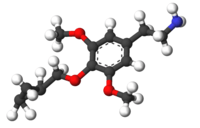Cyclopropylmescaline
 | |
 | |
| Names | |
|---|---|
| IUPAC name
2-(4-Cyclopropylmethoxy-3,5-dimethoxy-phenyl)-ethylamine | |
| Other names
4-Cyclopropylmethoxy-3,5-methoxy-phenethylamine 4-Cyclopropylmethoxy-3,5-methoxy-1-ethane | |
| Identifiers | |
| 207740-23-6 | |
| 3D model (Jmol) | Interactive image |
| ChEMBL | ChEMBL421458 |
| ChemSpider | 21106288 |
| PubChem | 44350143 |
| |
| |
| Properties | |
| C14H21NO3 | |
| Molar mass | 251.33 g/mol |
| Except where otherwise noted, data are given for materials in their standard state (at 25 °C [77 °F], 100 kPa). | |
| | |
| Infobox references | |
CPM, or 4-cyclopropylmethoxy-3,5-dimethoxy-phenethylamine, is a lesser-known psychedelic drug. CPM was first synthesized by Alexander Shulgin. In his book PiHKAL (Phenethylamines i Have Known And Loved), the dosage range is listed as 60–80 mg, and the duration listed as 12–18 hours. CPM produces powerful closed-eye imagery, visuals, and fantasies. It also causes enhancement of music.[1] Very little data exists about the pharmacological properties, metabolism, and toxicity of CPM.
References
- ↑ Shulgin, Alexander; Ann Shulgin (September 1991). PiHKAL: A Chemical Love Story. Berkeley, California: Transform Press. ISBN 0-9630096-0-5. OCLC 25627628.
See also
External links
This article is issued from Wikipedia - version of the 6/23/2016. The text is available under the Creative Commons Attribution/Share Alike but additional terms may apply for the media files.